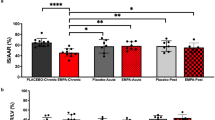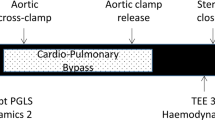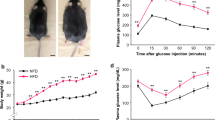Abstract
Coronary reperfusion improves ventricular function and survival after infarction, but the metabolic conditions at this time may not be optimal to protect the heart. The objective of this study was to evaluate if metabolic support with glucose-insulin-potassium (GIK) administered at the time of coronary reperfusion could elicit the same cardioprotection as GIK infusion during the entire ischemia/reperfusion period. Three groups of anesthetized, open-chest rats were subjected to 30 minutes of regional ischemia and 180 minutes of reperfusion. Groups 1 (controls) and 2 (GIKIR) received saline or GIK, respectively, throughout the whole experimental period, whereas a third group (GIKR) received GIK from the onset of reperfusion only. Infarct size was significantly reduced in the GIK-treated groups, compared with controls (GIKIR 44 ± 5% and GIKR 45 ± 5% vs. control 66 ± 4%; P < 0.05). Postischemic recovery of cardiac function improved when GIK was only administered during the reperfusion phase. Furthermore, infusion of GIK resulted in reduced plasma concentrations of free fatty acids and increased plasma glucose (both P < 0.05) compared with controls. This study demonstrates that glucose-insulin-potassium administration at the onset of the postischemic reperfusion period is as cardioprotective as administration of GIK during the entire ischemia/reperfusion period.
Similar content being viewed by others
References
Oliver MF, Opie LH. Effects of glucose and fatty acids on myocardial ischaemia and arrhythmias. Lancet 1994;343:155-158.
Sodi-Pallares D, Testelli MR, Fishleder BL, et al. Effects of an intravenous infusion of a potassium-glucose-insulin solution on the electrocardiographic signs of myocardial infarction. A preliminary clinical report. Am J Cardiol 1962;9:166-181.
Sidossis LS, Stuart CA, Shulman GI, Lopaschuk GD, Wolfe RR. Glucose plus insulin regulate fat oxidation by controlling the rate of fatty acid entry into the mitochondria. J Clin Invest 1996;98:2244-2250.
Fath-Ordoubadi F, Beatt KJ. Glucose-insulin-potassium therapy for treatment of acute myocardial infarction: An overview of randomized placebo-controlled trials. Circulation 1997;96:1152-1156.
Malmberg K, Rydén L, Efendic S, et al. Randomized trial of insulin-glucose infusion followed by subcutaneous insulin treatment in diabetic patients with acute myocardial infarction (DIGAMI Study): Effects on mortality at 1 year. J Am Coll Cardiol 1995;26:57-65.
Apstein CS, Taegtmeyer H. Glucose-insulin-potassium in acute myocardial infarction: The time has come for a large, prospective trial [editorial comment]. Circulation 1997;96:1074-1077.
Liu GS, Stanley AW, Downey JM. Ischaemic preconditioning is not dependent on neutrophils or glycolytic substrate at reperfusion in rabbit heart. Cardiovasc Res 1992;26:1195-1198.
Opie LH. The Heart (Physiology, from Cell to Circulation), 3rd ed. Philadelphia: Lippincott-Raven Publishers, 1998:523-525.
Vanoverschelde JL, Janier MF, Bakke JE, Marshall DR, Bergmann SR. Rate of glycolysis during ischemia determines extent of ischemic injury and functional recovery after reperfusion. Am J Physiol 1994;267:H1785-H1794.
McVeigh JJ, Lopaschuk GD. Dichloroacetate stimulation of glucose oxidation improves recovery of ischemic rat hearts. Am J Physiol 1990;259:H1079-1085.
Doenst T, Richwine RT, Bray MS, Goodwin GW, Frazier OH, Taegtmeyer H. Insulin improves functional and metabolic recovery of perfused working rat heart. Ann Thorac Surg 1999;67:1682-1688.
Gamble J, Lopaschuk GD. Insulin inhibition of 5'adenosine monophosphate-activated protein kinase in the heart results in activation of acetyl Coenzyme A carboxylase and inhibition of fatty acid oxidation. Metabolism 1997;46:1270-1274.
Diaz R, Paolasso EA, Piegas LS, et al. Metabolic modulation of acute myocardial infarction. The ECLA (Estudios Cardiologicos Latinoamerica) Collaborative Group. Circulation 1998;98:2227-2234.
Coleman GM, Gradinac S, Taegtmeyer H, Sweeney M, Frazier OH. Efficacy of metabolic support with glucoseinsulin-potassium for left ventricular pump failure after aortocoronary bypass surgery. Circulation 1989;80:I91-I96.
Randle PJ. Regulatory interactions between lipids and carbohydrates: The glucose fatty acid cycle after 35 years. Diabetes Metab Rev 1998;14:263-283.
Lopaschuk GD, Wambolt RB, Barr RL. An imbalance between glycolysis and glucose oxidation is a possible explanation for the detrimental effects of high levels of fatty acids during aerobic reperfusion of ischemic hearts. J Pharmacol Exp Ther 1993;264:135-144.
Schoonderwoerd K, Broekhoven-Schokker S, H_Ismann WC, Stam H. Enhanced lipolysis of myocardial triglycerides during low-flow ischemia and anoxia in the isolated rat heart. Basic Res Cardiol 1989;84:165-173.
Wardle CA, Riemersma RA. Hypoxia-stimulated glycerol production from the isolated perfused rat heart is mediated by non-adrenergic mechanisms. Basic Res Cardiol 1994;89:29-38.
Tani M, Neely JR. Role of intracellular Na+ in Ca2+ overload and depressed recovery of ventricular function of reperfused ischemic rat hearts. Possible involvement of H+-Na+ and Na+-Ca2+ exchanger. Circ Res 1989;65:1045-1056.
Glitsch HG, Tappe A. The Na+/K+ pump of cardiac Purkinje cells is preferentially fuelled by glycolytic ATP production. Pflügers Arch 1993;422:380-385.
Ferraro S, Bellarosa I, Genovese S, et al. Cardiac performance during insulin clamp: Its evaluation by bioimpedance measurement. Cardiologia 1997;42:189-194.
Jonassen AK, Brar BK, Mjos OD, Sack MN, Latchman DS, Yellon DM. Cardioprotective role of insulin at reperfusion may in part be due to an anti-apoptotic mechansim. Circulation 1999;100:A50.
Jonassen AK, Brar BK, Mjos OD, Sack MN, Latchman DS, Yellon DM. Insulin administered at reoxygenation exerts a cardioprotective effect in myocytes by a possible anti-apoptotic mechanism. J Mol Cell Cardiol 2000;32:757-764.
Heidenreich KA, Kummer JL. Inhibition of p38 mitogenactivated protein kinase by insulin in cultured fetal neurons.J. Biol Chem 1996;271:9891-9894.
Kummer JL, Rao PK, Heidenreich KA. Apoptosis induced by withdrawal of trophic factors is mediated by p38 mitogen-activated protein kinase. J Biol Chem 1997;272:20490-20494.
Author information
Authors and Affiliations
Rights and permissions
About this article
Cite this article
Jonassen, A.K., Aasum, E., Riemersma, R.A. et al. Glucose-Insulin-Potassium Reduces Infarct Size When Administered During Reperfusion. Cardiovasc Drugs Ther 14, 615–623 (2000). https://doi.org/10.1023/A:1007802630604
Issue Date:
DOI: https://doi.org/10.1023/A:1007802630604




